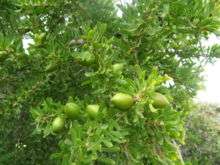Barbary ground squirrel
| Barbary ground squirrel Temporal range: Early Miocene - Recent | |
|---|---|
 | |
| Scientific classification | |
| Kingdom: | Animalia |
| Phylum: | Chordata |
| Class: | Mammalia |
| Order: | Rodentia |
| Family: | Sciuridae |
| Subfamily: | Xerinae |
| Tribe: | Xerini |
| Genus: | Atlantoxerus Forsyth Major, 1893 |
| Species: | A. getulus |
| Binomial name | |
| Atlantoxerus getulus (Linnaeus, 1758) | |
 | |
The Barbary ground squirrel (Atlantoxerus getulus) is a species of rodent in the family Sciuridae. It is monotypic within the genus Atlantoxerus.[2] It is endemic to Western Sahara, Algeria and Morocco and has been introduced into the Canary Islands. Its natural habitats are subtropical or tropical dry shrubland, temperate grassland and rocky areas where it lives colonially in burrows. It was first described by Linnaeus in 1758.
Description
The Barbary ground squirrel is a small species growing to a length of between 160 and 220 millimetres (6.3 and 8.7 in) with a bushy tail of a similar length. It weighs up to 350 grams (12 oz) and has short wiry hair. The general colour is greyish-brown or reddish-brown and there is a white stripe running along each side, and sometimes another along the spine. The belly is paler grey and the tail is longitudinally barred in black and grey.[2][3]
Distribution
.jpg)

The Barbary ground squirrel is found on the Barbary Coast of Western Sahara, Morocco and Algeria on the seaward side of the Atlas Mountains and was introduced into the island of Fuerteventura in the Canary Islands in 1965.[1] It is the only species of squirrel to inhabit Africa north of the Sahara.[2] Its habitat is arid rocky ground and it is found in mountainous regions up to an altitude of about 4,000 metres (13,000 ft).[2]
Biology
The Barbary ground squirrel is a colonial animal and lives in family groups in burrows in dry grassland, bushy and rocky areas including disturbed agricultural land, or in dens among rocks. It needs access to water but is not found in irrigated fields. It tends to come out to feed early in the morning and again in the evening, retreating into its burrow during the heat of the day. It feeds on plant material and a major part of its diet is the fruit and seeds of the argan tree (Argania spinosa). If the population builds up and food is scarce, the Barbary ground squirrel may migrate.[1][2] The females give birth to litters of up to four young, twice a year.[1]
Status
The population of the Barbary ground squirrel is believed to be stable and it is common over its range up to elevations of 2,000 metres (6,600 ft) but is more widely dispersed at higher altitudes. It is also less common at the eastern end of its range. It is listed in the IUCN Red List of Threatened Species as being of "Least Concern".[1]
References
- 1 2 3 4 5 Aulagnier, S. (2008). "Atlantoxerus getulus". IUCN Red List of Threatened Species. Version 2008. International Union for Conservation of Nature. Retrieved 6 January 2009.
- 1 2 3 4 5 Scott J. Steppan & Shawn M. Hamm (2000). "Atlantoxerus". Tree of Life Web Project. Retrieved 2013-02-14.
- ↑ Thorington, R. W. Jr. and R. S. Hoffman. 2005. Family Sciuridae. pp. 754–818 in Mammal Species of the World a Taxonomic and Geographic Reference. D. E. Wilson and D. M. Reeder eds. Johns Hopkins University Press, Baltimore
